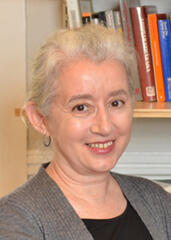 Janet Gyatso, Hershey Professor of Buddhist Studies, teaches seminars on Buddhist and Tibetan intellectual history and literature at Harvard Divinity School and in the Faculty of Arts and Sciences. Gyatso aims to “cultivate an experimental and convivial atmosphere in the classroom” that encourages students to draw connections between the past and present, interrogate a diverse set of primary sources, and create a community that allows students to feel comfortable taking intellectual risks and asking questions. This is particularly important in her field, which is often unfamiliar and engages with historical contexts that may seem distant from contemporary issues. Gyatso inspires her students to draw connections between the literature, philosophy, religion, and arts of the past and contemporary conversations on topics ranging from identity to gender to climate. By encouraging students to ask questions and find links between past and present, Gyatso is able to help them find an entryway into otherwise unfamiliar topics.
Janet Gyatso, Hershey Professor of Buddhist Studies, teaches seminars on Buddhist and Tibetan intellectual history and literature at Harvard Divinity School and in the Faculty of Arts and Sciences. Gyatso aims to “cultivate an experimental and convivial atmosphere in the classroom” that encourages students to draw connections between the past and present, interrogate a diverse set of primary sources, and create a community that allows students to feel comfortable taking intellectual risks and asking questions. This is particularly important in her field, which is often unfamiliar and engages with historical contexts that may seem distant from contemporary issues. Gyatso inspires her students to draw connections between the literature, philosophy, religion, and arts of the past and contemporary conversations on topics ranging from identity to gender to climate. By encouraging students to ask questions and find links between past and present, Gyatso is able to help them find an entryway into otherwise unfamiliar topics.
Cultivating a convivial academic setting
The benefits
For Gyatso, tapping into the “relevance of humanistic scholarship to things that are important to us right now” is a key to student engagement. Gyatso notes, “You have to balance both sides: show the continuities or the openings to comparable times and places on the one hand and talk about the specificity of deep historical context on the other.” For example, while a course may focus on the Indian literature from 200 BCE, Gyatso aims “to have some dimension of the class that speaks to the issues that are important for us now,” such as discussions on the ideals, assumptions, and principles of community put forward by authors and how the concept of “self” is presented in different contexts across time.
“The humanities provide students with the resources to be able to draw on their own experiences to study other human experiences, practices, and ideas over time, but without necessarily projecting their own historically contingent biases.”
The challenges
Gyatso encourages students to think creatively and “use their imagination” to connect with old and/or foreign texts. She notes that many students are initially hesitant to do this, so she herself models the practice of drawing connections, being open to testing out new ideas, and asking questions in the classroom. “I start to say, okay, what are we seeing here? What are their ideals? What are their assumptions? That's the kind of thing that I try to teach students to do.”
Takeaways and best practices
-
Link principles to the present.
Gyatso argues that courses should have explicit openings for ascertaining the principles within the content under discussion, and then juxtaposing those principles with contemporary issues. She aims for students to “learn all the scholarship and details,” while also “discerning what we can learn from those details, and what are the responsible ways to do that learning.” Gyatso also tries to ensure that students feel “acknowledged and legitimized” by “clarifying and helping to shape a student’s question” so that it can be addressed more effectively in the discussion. -
Show your own vulnerabilities.
Gyatso finds that letting go of the impulse to “appear to know everything as an instructor” leads to a much more vibrant classroom. Students often have an idealized vision of their teachers. Being honest about our own vulnerabilities leads students to own their own questions and vulnerabilities, and thereby to feel legitimized to participate in discussions more freely.
Bottom line
Gyatso’s teaching philosophy and seminar structures aim to promote student engagement by boosting their confidence to ask questions and rendering the content relevant to students’ own contexts.
